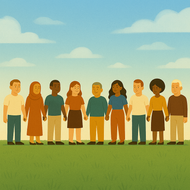Cultivating Tolerance and Unity in a Diverse World
Posted by Jay Suthers on Sep 11th, 2025
Cultivating greater tolerance for differences in opinion, beliefs, and behaviors is a crucial skill for fostering a more harmonious society. It requires a conscious effort to understand, empathize with, and accept perspectives that differ from our own. This article explores several strategies to help improve our tolerance for how people differ.
Understanding the Roots of Our Own Biases
Our opinions and beliefs are not formed in a vacuum; they are shaped by our personal experiences, cultural background, education, and the people we surround ourselves with. We often gravitate towards those who think like us, creating an "echo chamber" that reinforces our existing views. The first step to increasing tolerance is to recognize and challenge our own biases. Acknowledging that our own perspective is just one of many, and not necessarily the "right" one, is fundamental. It's important to be introspective and ask ourselves why we believe what we do and why we might react negatively to differing viewpoints.
Practicing Empathy and Active Listening
To truly understand another person's perspective, we must practice empathy—the ability to understand and share the feelings of another. Instead of immediately judging or dismissing an idea, take the time to listen actively. Active listening involves more than just hearing the words; it's about paying attention to the underlying emotions, context, and reasoning behind a person's beliefs. Ask open-ended questions to encourage them to elaborate, such as "Can you tell me more about why you feel that way?" or "What experiences led you to that conclusion?" This approach transforms a potential conflict into a productive dialogue. By seeking to understand rather than to win an argument, we create an environment where mutual respect can flourish.
Exposing Ourselves to Diverse Perspectives
We can’t learn about different perspectives if we only interact with people who are just like us. Intentionally seeking out diverse viewpoints is a powerful way to broaden our understanding and challenge our assumptions. This can be done by:
- Reading widely: Consume news, books, and articles from a variety of sources and authors with different backgrounds and political leanings.
- Engaging with diverse groups: Join clubs, volunteer for organizations, or attend events that expose you to people from different cultures, socioeconomic backgrounds, or belief systems.
- Travel: Experiencing different cultures firsthand can be a profound way to see the world from a new perspective.
- Seek to understand: This is where AI can be helpful. Use Google Gemini, Chat GPT, or Microsoft Copilot to ask questions and seek understanding. It helps to create an account so they can remember your previous conversations and add to them in a way that connects with you.
Embracing Cognitive and Behavioral Diversity
Tolerance extends beyond just opinions and beliefs; it also applies to how people process information, learn, and perform tasks. Some people are highly analytical and structured, while others are more intuitive and creative. Some prefer to work alone, while others thrive in collaborative environments. Recognizing and valuing these differences, known as cognitive diversity and behavioral diversity, can lead to more innovative and effective outcomes. For instance, in a team setting, a mix of different working styles can lead to more comprehensive problem-solving. Instead of seeing these differences as obstacles, we should view them as complementary strengths that can enrich our personal and professional lives.
Cultivating Patience and Humility
Building tolerance is a continuous process that requires both patience and humility. It's okay to disagree, but it's not okay to be disrespectful. When a conversation becomes heated, it’s important to take a step back and remember that a person’s identity is not defined by their beliefs. We must be humble enough to admit when we are wrong or when our understanding is incomplete. By approaching interactions with a mindset of learning rather than lecturing, we can create a space for genuine connection and understanding, even in the face of profound differences.
Above all, be kind. As has been said many times, we don't know what others are going through in life. Even if the other person is being unkind and disrespectful, you can take the high road or politely end the conversation.
Shop for Meditation Cushions Here.
I hope this is helpful but please let me know if you have any questions or thoughts.
Sincerely Yours,
Jay
If you would like to comment on this blog or have any questions, please feel free to Contact Sage Meditation Customer Service.

